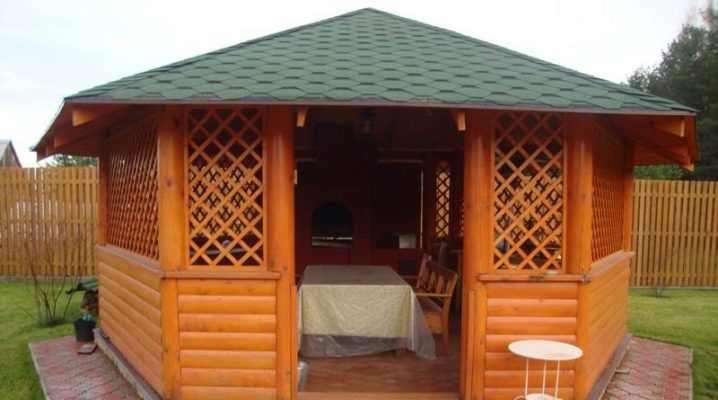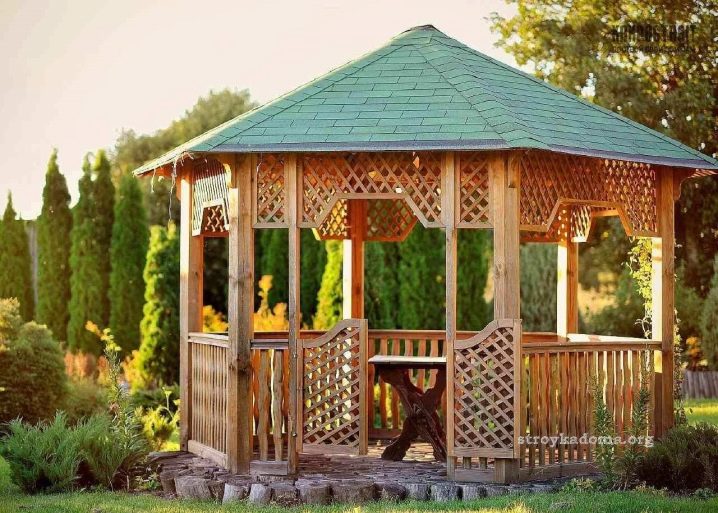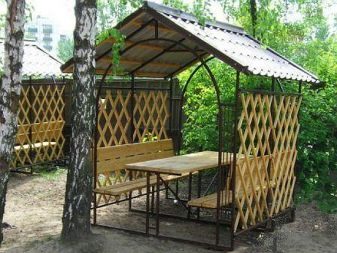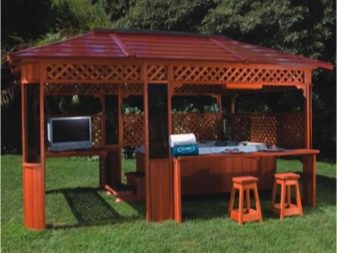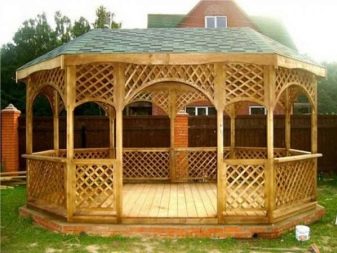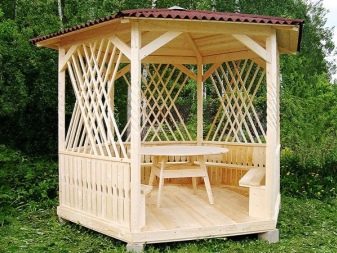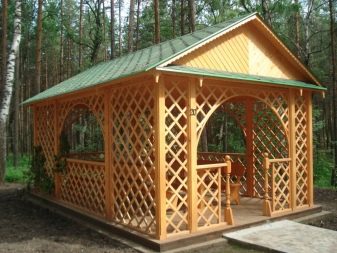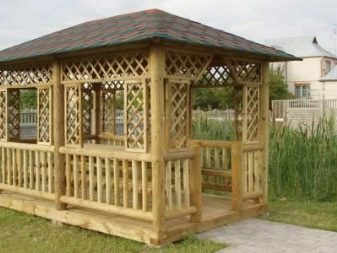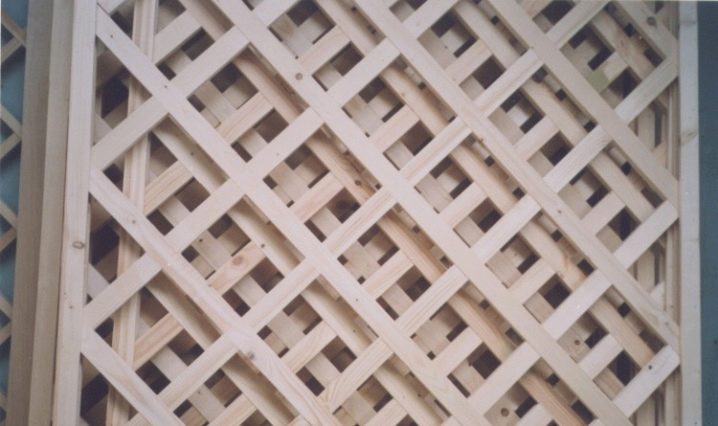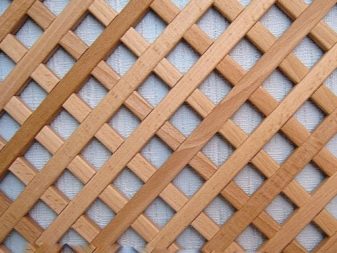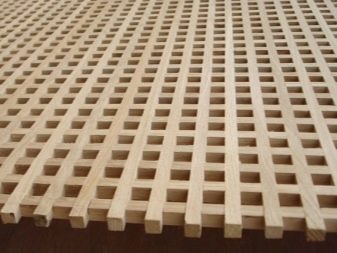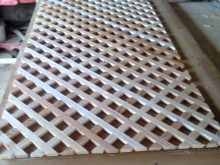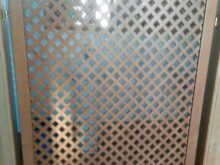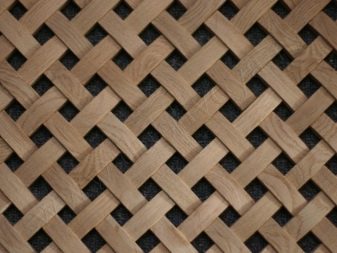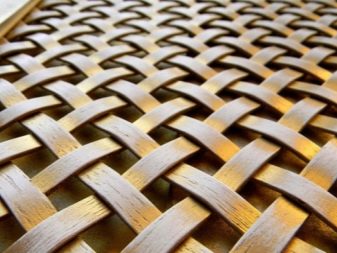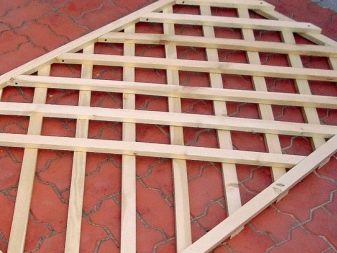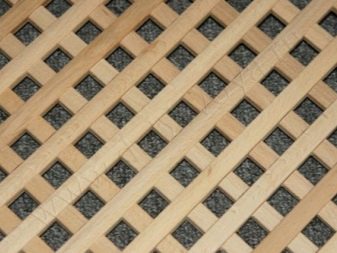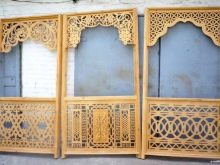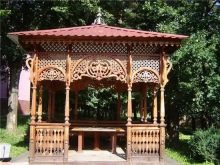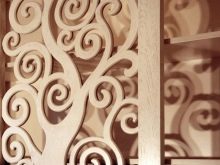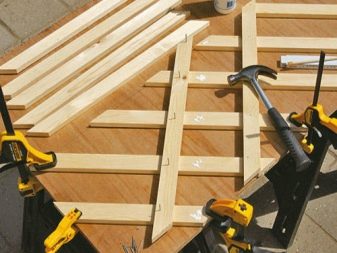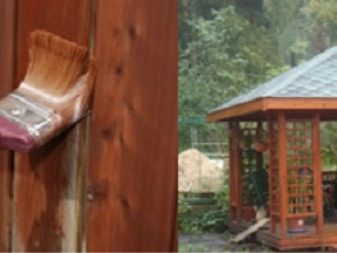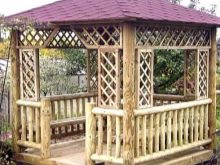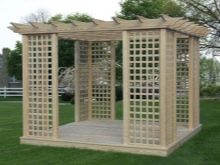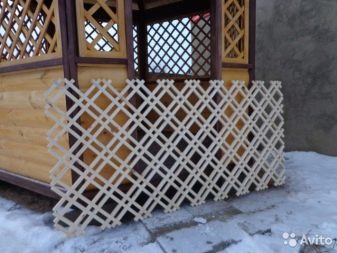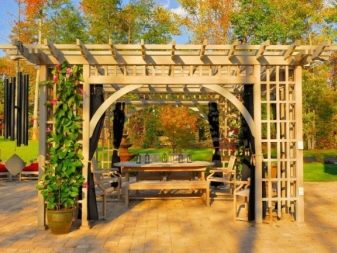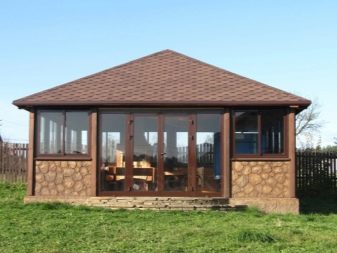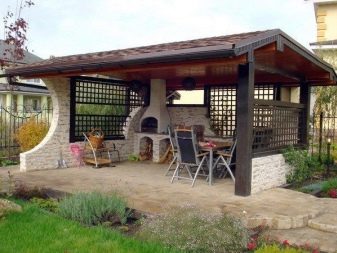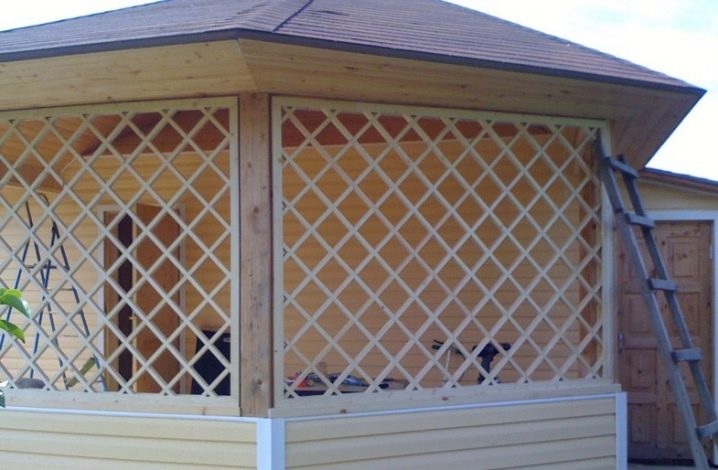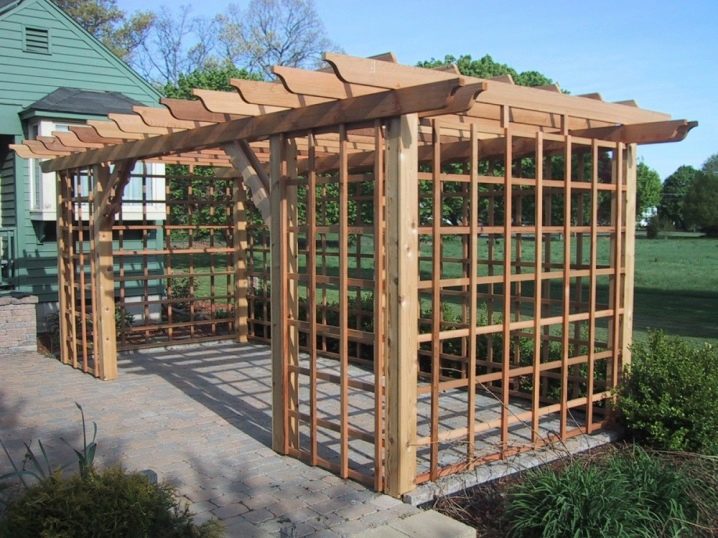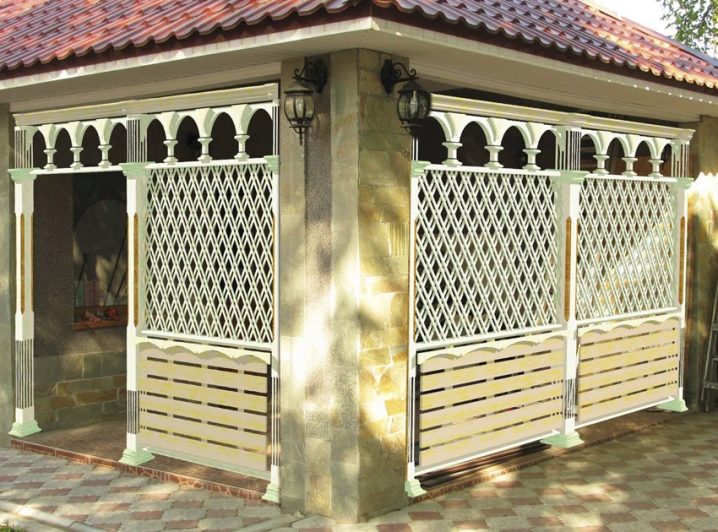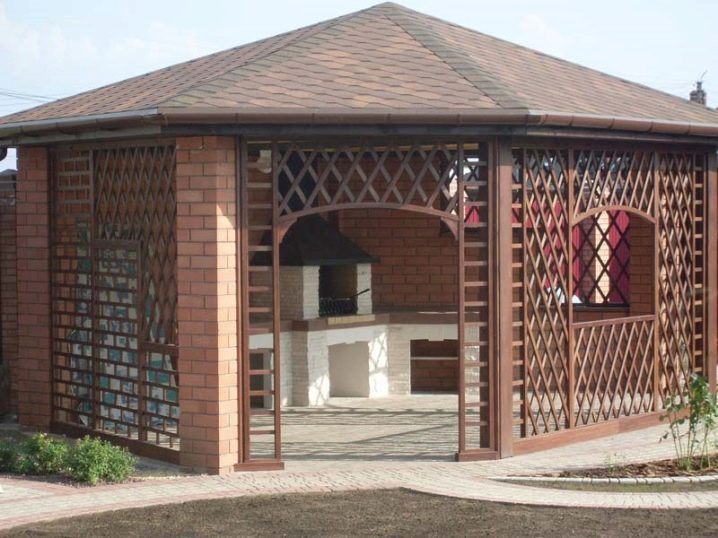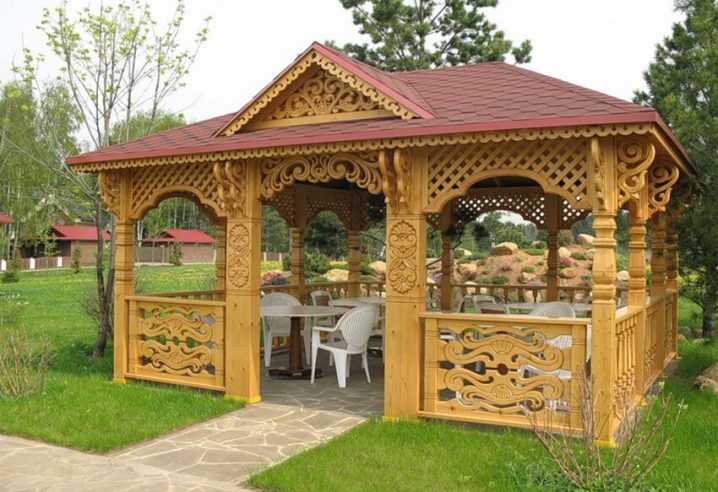Wooden lattices for an arbor: how to make your own hands?
A gazebo on the summer cottage is a very useful and necessary thing: it decorates the landscape, you can relax in it, have dinner with your family or cook barbecues and barbecues. This homestead structure should be not only durable and convenient, but also beautiful, for this you can use various decorative elements. Next, we will consider how to successfully make a wooden lattice for a gazebo with your own hands.
Features and benefits
The summerhouse can be constructed from various materials: wood, metal, brick or decorative stone. Regardless of this, decorative wooden lattices will always look harmoniously on it. Usually they are inserted into the non-blind openings on the side walls, fastening them in rectangular frames, but they may not fill the entire wall, made in the form of a fence or carved inserts under the roof.
The most common examples of such gratings for street buildings. in the form of inclined rails located crosswise to each other. They are very easy to make, a minimum of tools and cheap materials are required. But there are more labor-intensive projects with carved patterns, real works of art. Created from high-quality dried wood and securely fastened, such décor elements can serve in the summer cottage for several decades even under adverse weather conditions.
The advantages of homemade wooden arbors for arbors are:
- ease of manufacture, low cost material;
- aesthetic value - the appearance in front of a country house immediately changes noticeably for the better;
- inside the gazebo there will always be shade and coolness;
- universality for any type of arbor design;
- as the walls are not deaf, there will always be fresh air inside;
- if a meal is prepared in the gazebo, a stove, barbecue or barbecue is installed, then the smoke will quickly erode.
To create really reliable and durable decorative elements for a future gazebo, it is necessary to choose the source material.
Material selection
The material for creating such grids has its own specific requirements. It should be beautiful, well protected from moisture, temperature changes and sunlight. Since in most cases thin slats are used for the batten, strength is a determining factor.
Oak is good because at the desired strength it bends well. Expressive structure with pleasant shades of this tree are known to everyone. Oak wood is easily processed, perfectly polished and painted, and due to the high concentration of tannins in the composition is not very susceptible to rotting. Thin oak with a noble black color can look at the summer cottage just gorgeous.
Beech is also durable, relatively easy to process and bend. The wood texture has a yellowish-red hue with well pronounced annual rings. Details of this tree are widely used for the manufacture of exterior structures, including for the decorative elements of gazebos.
Ash reiki can have a yellowish-brown or red color with nice textures. This wood is dense and viscous, when drying it is well bent and does not crack, does not warp.In addition, the ash almost does not rot.
Birch parts for making decorative gratings are well chosen, due to the fact that this wood is very easy to cut, grind and drill, and its strength indicators are excellent. To ensure that the material does not rot, it should always be treated with an antiseptic and coated with varnish or transparent paint. It is best to choose Karelian birch for a decor with a pleasant and expressive texture.
The crate of aspen will have a pleasant reddish tint. The advantage of this type of wood is that it practically has no knots, it simplifies the process of processing, and the sectional view will be more beautiful. This material dries quickly, beautifully polished and painted.
You can choose other types of wood with useful properties and a beautiful texture: alder, linden, pine, cedar. With proper processing, they will all be strong and durable. Actually, it’s not even so important what kind of breed is chosen, you can take whatever is available, the main thing is to carry out all the carpentry work carefully and securely. Reviews say that oak and beech are the most popular in making arbors.
Types of partitions
The most common type of decorative partitions of this type is a grid of interwoven thin slats fixed on a wooden frame. Options for the manufacture of the main frame may be several. It should fit exactly into the side opening, with your own hands it can be made from bars, for example, with a cross section of 20 to 40 mm.
For a rectangular structure to be rigid and durable, the sides are best fixed with a spike connection. “In the overlay”, “in the half-tree”, “in the butt” or “nest-thorn”, should be chosen depending on their capabilities and skills. Some make the frame from old furniture or doorframes, the advantage is that there is already a ready-made spike connection.
The crate of the decorative opening inside the frame is made by thin slats of the same thickness. Components with a cross section of 5x10, 10x20 mm or others may be used. They are nailed or screwed with screws to the frame along its sides or at an inclined angle at the same distance crosswise. The easiest way is when one row of rails overlaps another, perpendicular to the first.
Another way to connect elements on the crate - "in sweat"when the slats do not overlap, as if buried in each other. For this, grooves are made in the joints at half-depths of the rail and into its thickness. Notches can be made manually with a hacksaw or chisel.
This method is quite laborious and significantly increases the time for assembling the gazebo, but as a result, you can get a one-piece neat lattice, in addition, its strength increases.
The partition may not be a team of individual strips, and made from a single sheet of plywood, chipboard, laminated board or board. To create a lattice in them cut openwork patterns, as a result, you can get an elegant carved lattice. The advantages of this method in strength, no need for assembly, the originality of the pattern, but the mass of the structure can be much greater than that of the assembled from the slats.
Independent production
If you want to make decorative elements for a tree gazebo with your own hands, you must first choose wood for the frame and slats, calculate the area of the openings and make drawings for future openwork grids.By drawing you can immediately calculate the number and length of the rails, as well as the required number of fasteners.
The following tools and building materials may be needed to assemble the structure:
- hacksaw;
- hammer;
- nails;
- tape measure and pencil;
- bars for the frame;
- battens for crates;
- varnish on wood and brush.
First, the frame for the grille is assembled in accordance with the dimensions of the measured arbor opening. You can bond it to the joint with nails or barbed joint, for strength, use wood glue. Then, pieces of the required length are cut out of the rails, laid out on the frame of the joint, elements are nailed alternately. When the grille is ready, it is necessary to carefully treat it with varnish, let it dry and mount it on the nails or screws in the opening.
You can varnish the slats before you sheathe the frameso hard-to-reach places will be processed, and the process itself is simplified. But then the dried coating can be destroyed in the attachment points to the tree with nails, so after the assembly it is worth painting these areas again.
Decorative techniques: ideas
Diagonal lattices, which are often found on wooden arbors, give an original and stylish look.The most commonly used angle of 45 degrees, the slats intersect at right angles to each other. Only the pitch of the individual elements can differ. If it is frequent and does not exceed 10 - 15 cm, then a rather dense screen is created, perfectly protecting from the sun, which allows to hide the internal situation. A wider step of the rails 15 - 25 cm can create an atmosphere of lightness and openness, then the interior of the gazebo almost merges with the surrounding landscape.
The direct location of intersecting rails will look even more original., you can combine them with sloping, for example, on adjacent walls. Still it is very successful to use such constructions for a support of climbers, then instead of walls an arbor will have a real hedge. It is possible with the help of several rails of different widths to create a non-standard complex pattern with different pitch and openings, it is enough just to show your imagination.
Bonded slats for crates, they are also called trellis, can be connected according to different schemes. The technology of connection and fastening on the frame will not be much different, but the choice of the pattern is the most diverse, it is practically not organic.The already mentioned lattice schemes with inclined slats are called "diamond", with straight lines - "square", diverging from the bottom upwards of the trellis - "mill", inclined with alternating direction - "chevron". There are other schemes, you can create your own design.
It should be borne in mind that the lattices made of wood are appropriate not only on the walls, but also on the roof of the arbor. If you make the top of the construction of massive bars, intersecting at a right angle, and letting them climb climbing plants over them, then such a project will look fantastic. From the rain and the scorching sun, such a "roof" does not protect, but will add lightness to any architectural solution of the garden pavilion. Often such lattice upper floors are made in the pregolas, which have become especially popular in recent years.
In order to ensure maximum openness in the backyard gazebo, it is not necessary to make its grilles in the entire wall. It is enough to make openwork fences with trellis, they can simultaneously serve as backs of internal benches, and use beautiful carved skates along the top under the roof.
Often caring owners in their suburban area make glazing gazebos.Their advantages are obvious, they perfectly protect from cold and rain, they can cook food and arrange family gatherings in any weather. A good example of glazed pavilions are Finnish enclosed versions with 6 or 8 walls and with an internal stove. Interior decorative grilles can be glazed with ordinary mineral, organic, tempered glass or transparent polycarbonate.
Often the question arises of painting the supporting elements of gazebos and its decorative grids. Many owners, especially looking at the arrangement of modern courtyards, choose bright bright colors for their country buildings. This is not entirely correct, since any wood itself has a pleasant natural color and does not need to be painted.
Another issue is its protection, so that the tree does not rot, does not swell and preserves the integrity of its surface enough to process a transparent varnish or mastic.
Beautiful examples for inspiration.
An elegant example of the simplest pattern with inclined slats. The appearance of the arbor immediately transformed.
Pregol with trellises with straight slats. The ease of manufacture, however, gives a stylish design.
A complex combination of several patterns on wooden gratings.
Different types of patterns on wooden gratings.
The stunning design of a pergola from prefabricated slats and with carved wood.
For a simple making of a wooden lattice, see the following video.
